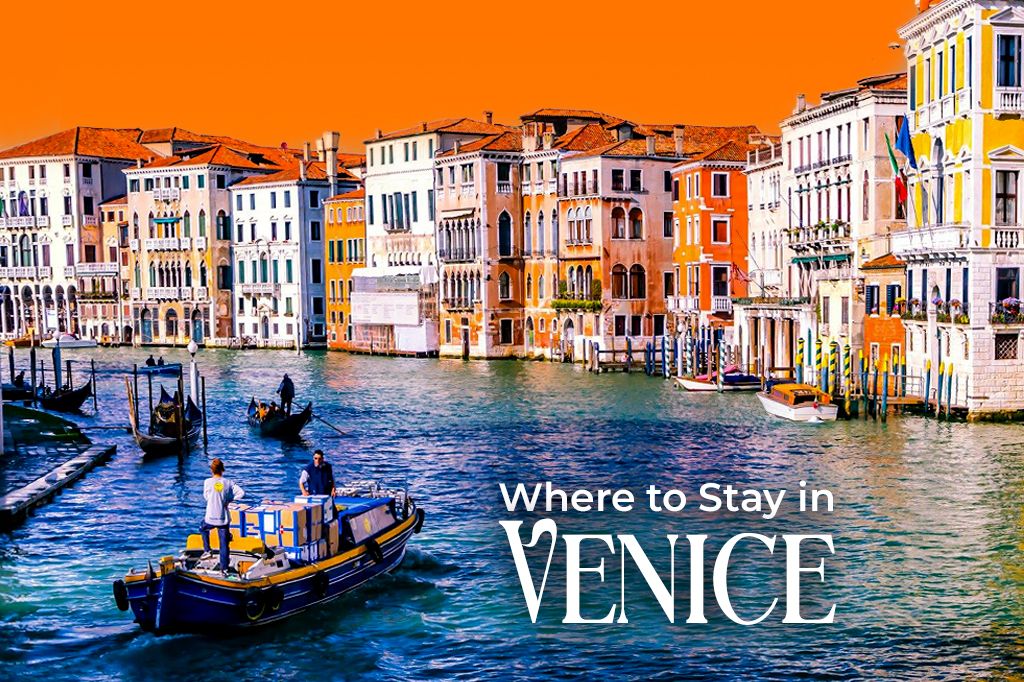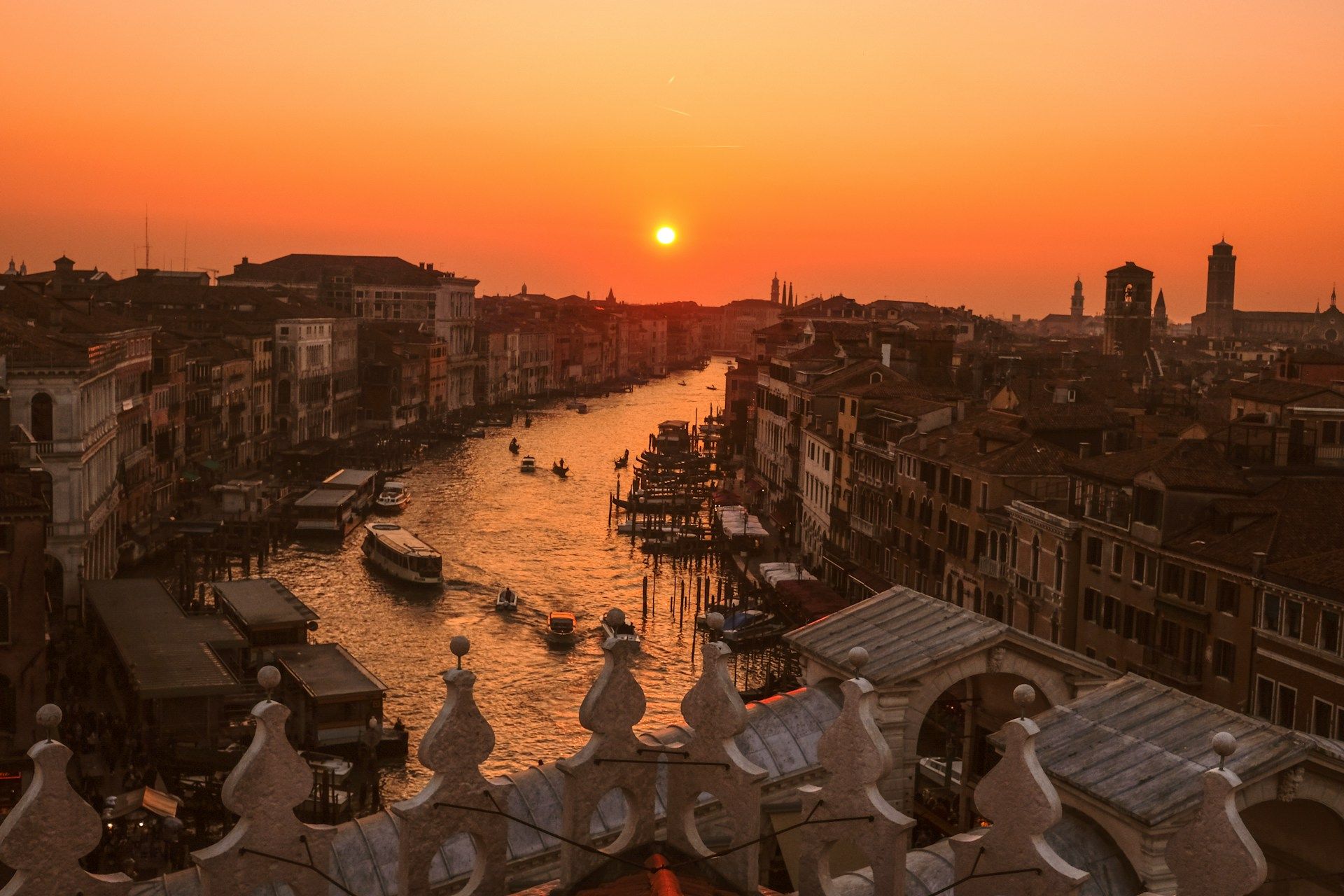Where to Stay in Venice, Italy: The Ultimate Area Guide for Every Kind of Traveler
Robin•May 02, 2025
Traveling to Italy is a dream come true. No other city is as unique and beautiful as Venice. If you want to spend a few days there, here’s a breakdown of the best places to stay in Venice!

Picture by Kit Suman on Unsplash
You could do as many people do, and visit Venice only as a day trip, but that way you’ll be losing a lot of the experience. Let’s be real, as fun as day trips are, and they are incredible, the feeling is just not the same as staying in a place. If you truly want to experience Venice and learn more about it, you have to stay there, at least for a night. That way, you can see the city at all times, from the slow mornings, with the first rays of sun glimmering in the waters, to the late nights at a local restaurant, enjoying a quiet and romantic dinner. During those times, the city empties almost completely of tourists and becomes more private and magical.
Now that you have decided that you’re definitely staying in Venice, we can talk about where. While the city itself is quite small (you can actually walk from one side to the other in less than an hour), the area you’re staying in can change the experience a lot. If you haven’t seen a map of Venice, it is divided a bit like a pie with Rialto market in its center, into six sixths, or sestieri in Italian. Each has their own personality, even if they’re really close to one another.
But before we start talking about each sestiere and what you can see, if you want to keep your memories for a long time, and keep your family and friends updated about your trip, you need a reliable internet connection. Stay connected with Yoho Mobile eSIMs! They’re easy to get, easy to install, and they will save you a lot of money on roaming costs. Don’t forget to use out promo code YOHO12 for a 12% discount!
Where to Stay in Venice: The Six Sestieri
San Marco
Probably the one you’ve seen the most, especially in pictures and postcards. It’s so iconic with its marble colonnades, cafes, orchestras, designer shop-windows, and the Grand Canal, so ideal for first-timers. For some people, it might be too much. During the day is crowded, with so many people coming from all parts of the world to spend a few hours. And it’s so ceremonial and theatrical that when the night settles, the piazzas look more like a memory than an actual city.
If you want iconic views, then you have to go to St Marco’s Basilica. Inside you’ll find the most beautiful golden mosaics, and up its terrace you can see the whole piazza and people going around. The Doge’s Palace is also there, and that is a must when visiting Venice. Since you’re staying the evening, you can also catch an opera at Teatro La Fenice.

Photo by Kasia Derenda on Unsplash
Where to Stay in San Marco
-
Hotel Becher: The area can be a bit expensive, so having budget-friendly options is great. This property is next to a small canal, and the staff is friendly.
-
Baglioni Hotel Luna: This is actually the oldest guest ledger in the city. Opened since 1118, and pretty quiet for being 80 meters away from the piazza.
-
The Grittti Palace: If you’re looking for the best of the best, you can stay in this 15th-century noble residence.
Dorsoduro
As iconic as San Marco is, Dorsoduro is more popular with the intellectuals, artists, and the bohemian people. It has a bit of an art-school energy, and indeed, there’s the Ca’ Foscari University there. It’s quieter and inviting to reflection, with many galleries to visit in the afternoons and colorful sunsets along the Zattere waterfront.
There are many inviting places to visit in Dorsoduro. For history and architecture lovers, you have the Basilica di Santa Maria della Salute, with its baroque silhouette right at the Grand Canal’s entrance. For an afternoon stroll, you can follow the Zattere promenade, which you can not complete without having some gelato from Nico.

Photo by Diego Gennaro on Unsplash
Where to stay in Dorsoduro
-
Combo Venezia: It’s stylish and it’s not quite a hotel nor a hostel, but you do have great prices and canal views.
-
Ca’ Maria Adele: Very exclusive, with only six rooms, but so beautiful. You can have breakfast on a private dock and see the Salute’s domes from your room.
Castello
Castello might not be your first pick when you’re deciding where to stay in Venice. If it’s your first time, other sestieri are far more visually attractive and enticing. But, if you’re a veteran in Italy trips and care to look with a bit more detail, you start to see an incredible charm. Castello is full of gardens, historical landmarks, and maritime lore. It’s more residential and less touristic than San Marco or Dorsoduro.
For a quiet place to take a stroll, there’s the Giardini della Biennale, an expansive park that hosts the Venice Biennale’s art exhibitions. If you like to see unique historic places, the Arsenale di Venezia, where the great ships that make the city famous were built.
Where to Stay at Castello
-
Hotel Citta di Milano: It’s indeed basic and affordable, but sometimes you just want a simple comfort to spend your money elsewhere.
-
Antico Panada: If you want something classic, look no further. It’s near Via Garibaldi and with the traditional decor and the local atmosphere, is great value for its cost.
-
Hotel Danieli: A photographer’s dream, right at the waterfront, with ornate interior, crystal chandeliers, and incredible views of the lagoon. If you’re celebrating a special occasion, is hard to think of a better place.
Cannaregio
From all the sestieri in Venice, Cannaregio is where most Venetian people you’ll see. It’s actually where most of the population lives, and that means it’s cheaper and excellent if you’re staying for more than a couple of days. On the downsides, you’ll have to walk half an hour to visit the main attractions, and if you happen to visit during the acqua alta, there’s a greater chance of floods.
Cannaregio has been a residential area for many centuries now. To learn more about its history, take a stroll through the Jewish Ghetto, founded in 1516, and visit the Synagogue Museum. If you like art, you have to go to the Galleria Giorgio Franchetti, a Gothic palace transformed into an art trove.

Photo by Cristina Gottardi on Unsplash
Where to Stay in Cannaregio
-
Madame Garden Retreat: Once you’re tired of exploring the city, you’ll want to rest in a secluded place, like a jasmine garden.
-
Il Palazzo Experimental: If you’re a bit tired of the traditional designs and the repurposed buildings, here’s a unique hotel on the edge of the Zattere.
San Polo
You’ve heard a lot about Venice and the wonders of many of its sestieri, and there’s still more. If you want vibrant and lively, with a historic vibe yet a modern touch, then San Polo is for you. It’s a bustling area, that’s for sure, with busy markets filled to the brim with good Italian produce, and plenty of winding alleyways to explore.
San Polo has one of the most iconic views in all of Venice, right on the Rialto Bridge. If you stand in the very center, you can see both sides of the city at once, with all its shops and people. On Rialto Market, you’ll find one of the oldest and most famous markets. Take the time to explore it, and try the street food! Afterwards, you can visit the Basilica del Frari, a majestic Gothic church, or the Scuola Grande di San Rocco, with its quite dramatic Tintoretto paintings.
Where to Stay in San Polo
-
Hotel Alla Fava: Being on a budget does not mean staying less central. This hotel is small and affordable, and it has a great location near the Rialto Market.
-
Hotel Palazzo Abadessa: If you’re looking for a refined yet reasonable stay in Venice, in a historical building with great views, look no further. It’s quieter than other central hotels.
-
Hotel Antiche Figure: It’s quite a charming sight, along the Grand Canal, and it has some really luxurious rooms.
Santa Croce
And we’ve arrived at the last sixth of Venice, but no less appealing. If you arrived in Venice by train, you’ve already seen a bit of it and probably liked it quite a bit. It’s not as touristic as other sestieri, and its charm is more subdued and quiet. It has little charming canals, with narrow alleys and lots of local shops, bars, and restaurants. If you want to be close to the action and attractions during the day, but retreat to the quietness in the afternoon, this area is perfect for you.
Being residential doesn’t mean void of interesting places to see. In Santa Croce, you can visit the Santa Croce Church, a hidden gem of which you hear little to nothing on Venice tourist guides. To sit with friends and unwind after a tiring day of walking, there’s the Campo San Giacomo dell’Orio, a square with plenty of cafes and bars.
Where to Stay in Santa Croce
-
Hotel Abbazia: For a reasonable price, you can stay in this charming hotel. It used to be a monastery, and the simple accommodations and peaceful feeling haven’t changed that much.
-
Hotel L’Orologio: It’s quite close to Piazzale Roma, and it has a modern Venetian feel. You can sense it in its sophisticated interior design and the rooftop terrace.
-
Aman Venice: Another 16th-century palace transformed into a very comfortable and luxurious hotel. It’s right on the Grand Canal and perfect if you want great service and peace.
FAQs about staying in Venice
What does a “5-minute walk” mean in Venice?
Even without setting foot in Venice, you know its layout is pretty uncommon. It has many canals, with connecting bridges, and narrow streets that can be blocked by tourists. Even if two places are close to each other on a map doesn’t mean it’s going to be a 5-minute walk. With the slowdown and detours, you’ll likely make it in 15 minutes instead.
What happens if it floods?
Venetian people call this phenomenon acqua alta, which is only Italian for high water, and it is to be expected of a city built in a lagoon right next to the sea. This unusually high tide can cause the water level to rise significantly in the canals, and it can submerge parts of the city. It sounds scary, but the city and its people are quite adapted, and the damage is minimal. But it can disrupt your vacations, so try planning more flexibly if you’re traveling during the winter.
Can you really walk in everywhere in Venice?
Yes, as we already said, the city is quite small, and you can walk from one end to the other in under an hour. It’s also the easiest way to explore the city, since there are no cars and bikes can be hard to maneuver on the narrow alleyways and cobblestone streets.
